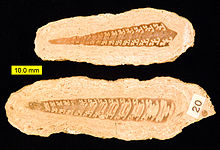

Oncolites are sedimentary structures composed of oncoids, which are layered structures formed by cyanobacterial growth. Oncolites are very similar to stromatolites, but, instead of forming columns, they form approximately spherical structures.[1] The oncoids often form around a central nucleus, such as a shell fragment,[2] and a calcium carbonate structure is deposited by encrusting microbes. Oncolites are indicators of warm waters in the photic zone, but are also known in contemporary freshwater environments.[3] These structures rarely exceed 10 cm in diameter.
Oncolites may have either a porostromate or spongiostromate texture. Most oncolites are spongiostromate, having no recognisable cellular texture or microstructure. Porostromate oncolites are mostly unknown during the Precambrian; since the Eocene they have mostly been confined to freshwater environments.[4]
- ^ Corsetti, F.A.; Awramik, S.M.; Pierce, D. (2003-04-15). "A complex microbiota from snowball Earth times: Microfossils from the Neoproterozoic Kingston Peak Formation, Death Valley, USA". Proceedings of the National Academy of Sciences. 100 (8): 4399–4404. Bibcode:2003PNAS..100.4399C. doi:10.1073/pnas.0730560100. PMC 153566. PMID 12682298.
- ^ Gutschick, R.C.; Perry, T.G. (1959-11-01). "Sappington (Kinderhookian) sponges and their environment [Montana]". Journal of Paleontology. 33 (6): 977–985. Retrieved 2007-06-28.
- ^ Riding, Robert. 1991. Calcareous Algae and Stromatolites, pp. 32. Springer-Verlag Press.
- ^ Monty, C. L. (1981). "Spongiostromate vs. Porostromate Stromatolites and Oncolites". In Monty, Claude (ed.). Phanerozoic Stromatolites. Berlin, Heidelberg: Springer. pp. 1–4. doi:10.1007/978-3-642-67913-1_1. ISBN 978-3-642-67913-1.